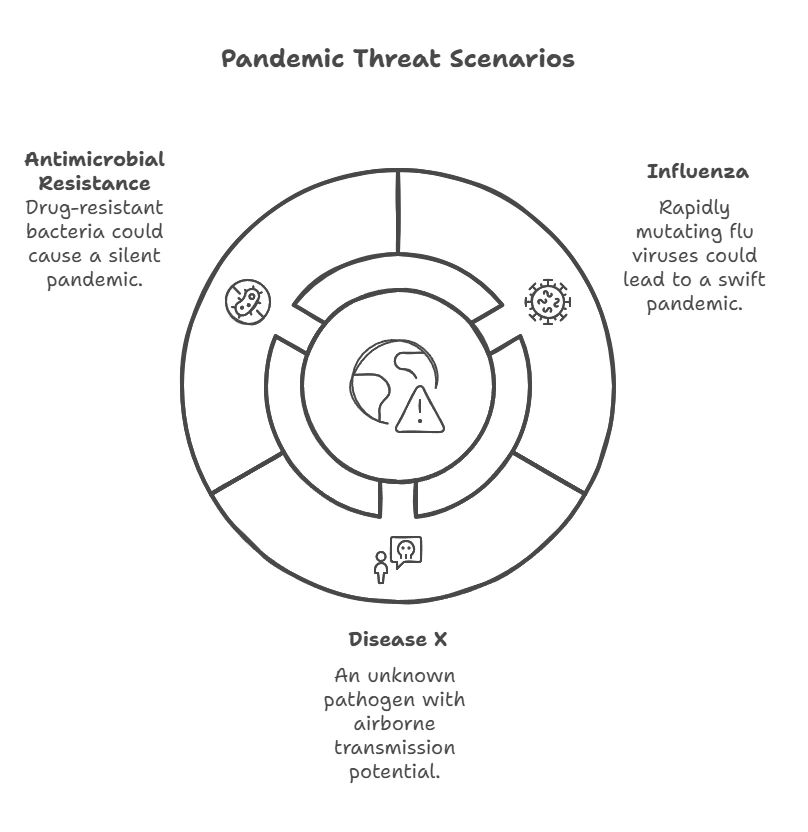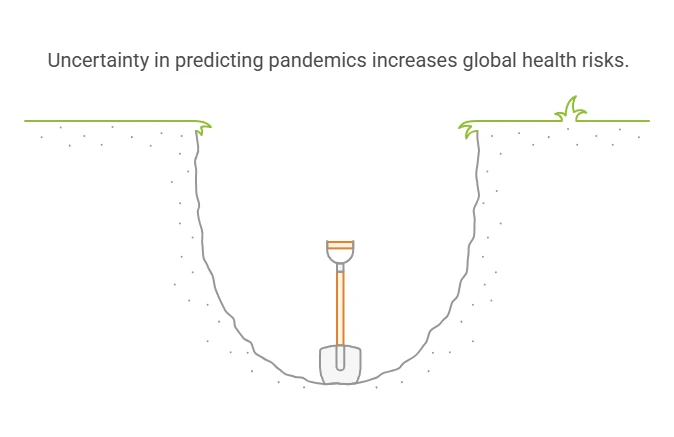Author: Hrishikesh Jadhav
Table of Contents
Let’s be honest: after COVID-19, the word “pandemic” sends a shiver down everyone’s spine. But here’s the uncomfortable truth: another pandemic isn’t a matter of if, but when.
Scientists agree that global outbreaks are inevitable. Thanks to factors like climate change, urbanization, and our interconnected world.
So, what year will the next pandemic strike? I can’t predict the future. But, I can discuss the risks, past lessons, and our (lack of) preparations for the next big threat.
Are We Prepared for the Next Pandemic?
The short answer? We’re better prepared than in 2019, but not nearly ready enough.
COVID-19 exposed big flaws in global health systems.
Vaccine rollouts were slow, and public messages were inconsistent. Since then, the World Health Organization (WHO) has pushed for better pandemic plans. But progress is slow.
A 2023 report by the Global Preparedness Monitoring Board found that only 20% of countries updated their pandemic response strategies after COVID.
Funding is a hurdle, too. Low-income nations lack basic healthcare. So, early outbreak detection is nearly impossible.
The silver lining? Technology is on our side.
AI tools, such as BlueDot, can now predict disease outbreaks. They do this by looking at travel patterns and environmental data.
COVID improved mRNA vaccine platforms. We could now make shots for new pathogens in under 100 days. But without global cooperation, these innovations won’t reach everyone equally.
What Will Cause the Next Pandemic?
Most experts point to zoonotic diseases, viruses that jump from animals to humans as the most likely culprits.
COVID-19 likely originated in bats, while past pandemics like HIV and Ebola also stemmed from animal hosts.
Deforestation, wildlife trade, and climate change are accelerating these spillover events. For instance, melting Arctic ice is exposing ancient pathogens, while hotter temperatures expand the range of disease-carrying mosquitoes.
Top Contenders for the Next Pandemic:

- Influenza: Flu viruses mutate rapidly, and a novel strain could emerge from poultry or swine farms. The 1918 Spanish flu killed 50 million people—today, a similar virus could spread even faster.
- Disease X: The WHO uses this term for an unknown pathogen with pandemic potential. Think a deadly cousin of COVID or a hemorrhagic fever with airborne transmission.
- Antimicrobial Resistance (AMR): While not a virus, drug-resistant bacteria like MRSA could trigger a silent pandemic. By 2050, AMR might claim 10 million lives yearly if left unchecked (source).
What Was the Last Pandemic Before COVID?
Before COVID-19, the world faced the 2009 H1N1 swine flu pandemic.
The virus came from pigs. It infected over 1.4 billion people worldwide, but its mortality rate (0.01–0.03%) was lower than COVID’s.
Critics said the WHO overreacted by declaring a pandemic. But, the episode taught us valuable lessons about vaccine distribution and public trust.
Pandemics of the Past 100 Years:
| Year | Pandemic | Cause | Global Deaths |
|---|---|---|---|
| 1918 | Spanish Flu | H1N1 (avian origin) | 50 million |
| 1957 | Asian Flu | H2N2 (avian origin) | 1–2 million |
| 1968 | Hong Kong Flu | H3N2 (avian origin) | 1 million |
| 2009 | Swine Flu | H1N1 (swine origin) | 284,000 |
| 2020 | COVID-19 | SARS-CoV-2 (likely bat origin) | 7 million+ |
Predicting the Next Pandemic: Why Timing Is Everything?

No one can pinpoint the exact year, but models suggest we’re overdue.
Pandemics have occurred every 20 to 50 years throughout history. COVID-19 ended a 100-year “drought” since the Spanish flu. But population growth and ecological disruption are making the gaps shorter.
A 2022 study in PNAS estimated a 2% annual probability of a COVID-level pandemic. That means there’s a 50% chance of another pandemic within the next 25 years. Scary? Yes. Inevitable? But here’s the good news: we can reduce the damage.
How to Prevent (or Survive) the Next Pandemic?
- Invest in Global Health Equity: Only 32% of people in low-income countries have received a COVID vaccine. Initiatives like COVAX aim to fix this, but long-term funding is key.
- Stop Spillovers at the Source: Protect wildlife habitats, regulate wet markets, and monitor livestock health. Projects like PREDICT have identified 1,200+ novel viruses in animals since 2009.
- Boost Local Healthcare: Training community health workers and stockpiling PPE in rural clinics can buy critical time during outbreaks.
- Trust Science, Not Rumors: Misinformation fueled vaccine hesitancy during COVID. Transparent communication saves lives.
Final Thoughts: Vigilance Over Fear
Pandemics are as old as humanity itself. But for the first time in history, we have the tools to predict, contain, and treat outbreaks faster than ever. The next pandemic will come, maybe in 5 years, maybe in 30. But by learning from COVID, investing in science, and prioritizing equity, we can ensure it doesn’t devastate our world again.
Stay informed. Stay prepared. And most importantly, don’t panic because preparedness, not paranoia, is our best defense.


2 thoughts on “What Year Will the Next Pandemic Be? Urgent 2030 Predictions (Are You Ready?)”